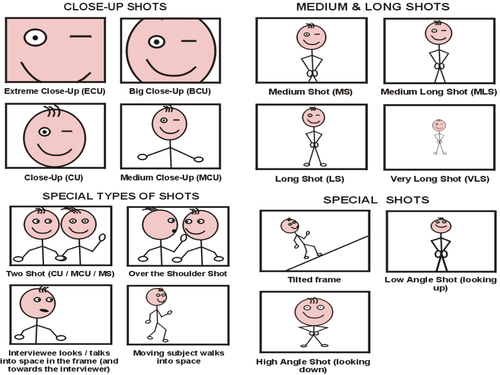different media forms forms have different media language as an introduction is worth looking overall at what constitutes the language of moving image. we are looking at the language so we can understand the rules and conventions that are there.
The camera is a important tool as it determines the focus and depth of field. the focus can be used to direct and prioritise certain information. for example, it should determine where the audience is focusing on and to look at.
High angle / Low angle / bulls-eye / birds eye / canted angle
Tracking / Panning / Craning / Tilting / Hand held / Steadicam
Establishing Shot / Long Shot / Medium Shot / Close-up / Big Close-Up / Extreme Close Up (students often struggle with the first and the last again issues with SCALE, SIZE & SPACE, so practice is really important)
Insert Shot
shot size is really important. for example with extreme closeup it gives you a more dramatic on screen moment of the character rather than a far away shot as it does not dramatics the scene as much. also with far away shots it shows a more dramatic sense of the scene.
insert shot is the shot that is inserted to focus of the thing that is being focused on in the scene.
edit
Moving from Camera to Edit, would be to compare the way that the camera can frame and position characters and thereby the audience by creating ‘subjectivity‘ and empathy. This is so important for creating a story, characters, a theme and of course communicate meaning Similarly, the way in which images are edited together has a massive significance in terms of communicating an idea and of creating meaning.
editing stiches together your camera work.
- EDIT ON ACTION
- EDIT ON A MATCHING SHAPE, COLOUR, THEME
- EDIT ON A LOOK, A GLANCE, EYELINE
- EDIT ON A SOUND BRIDGE
- EDIT ON A CHANGE OF SHOT SIZE
- EDIT ON A CHANGE OF SHOT CAMERA POSITION (+30′)
when my character was pushed I cut on the action of him falling. I also cut on the focus of the hand grasping the sand and letting go I cut after the action of the hand grasping the ground.
parallel editing
The use of sequential editing (editing one clip to another) allows for a number of key concepts to be produced:
- parallel editing: two events editing together – so that they may be happening at the same time, or not?
- flashback / flash-forward – allowing time to shift
montage: telling a long story in a short period of time, this can be done by taking the important events in the story you are trying to tell and cut them together to make a sequence that therefore tells the story in a short time. Montage can also be used as symbolism.
logical shot progression
Conventional shot progression – to create VERISIMILITUDE (ie realism, believability) usually involves the following shots (although not always in the same order).
The use of these shots allow the audience to understand SPATIAL RELATIONSHIPS between locations, people, movements etc. The length of shot will determine the drama, empathy, theme etc. The choice of how to sequence each shot will determine the AESTHETIC QUALITY of the product. The next sequence will then follow a similar pattern, which again allows the audience to understand concepts such as SPACE, TIME, DISTANCE, MOVEMENT, MOTIVATION, PLOT, THEME etc.
shot reverse shot
he Shot / Reverse Shot a really good starting point for students to both think about and produce moving image products. The basic sequence runs from a wide angle master shot that is at a 90′ angle to (usually) two characters. This sets up the visual space and allows the film-maker to to then shoot separate close-ups, that if connected through an eye-line match are able to give the impression that they are opposite each other talking. The shots are usually over the shoulder.

